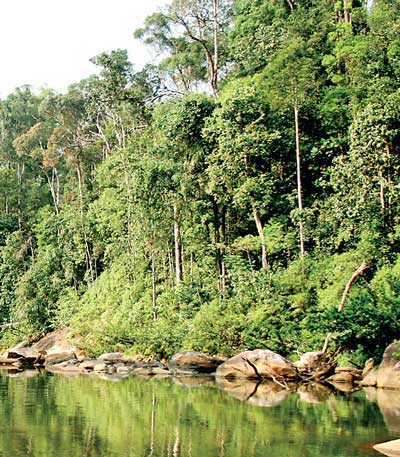Monday Mar 17, 2025
Monday Mar 17, 2025
Tuesday, 16 May 2017 00:00 - - {{hitsCtrl.values.hits}}
The destruction of forests in many Asian countries continues apace, raising fears that one of the world’s key Sustainable Development Goals may not be achieved by the 2030 deadline, the UN’s Food and Agriculture Organization (FAO) warned yesterday.
When the SDGs were formulated and agreed by 193 countries in 2015, forests were explicitly mentioned in order that they be aided through the protection, restoration and promotion of sustainable forests while halting and reversing associated land degradation and the loss of biodiversity.
“While forests are critical to achieving the SDGs, they continue to be degraded and lost at a rate of 3.3 million hectares per year,” said Patrick Durst, Senior Forestry Officer at the FAO Regional Office for Asia and the Pacific. “In this region, forests continue to be converted to agriculture, destroyed and replaced by man-made infrastructure, housing, mining, and other land uses. Forest fires also continue to pose a threat to the region.”
Covering one-third of the earth’s surface, forests provide an invaluable variety of social, economic and environmental benefits. Forests and trees sustain and protect all life in invaluable ways. They provide the clean air that we breathe and the water that we drink. Home to more than 80% of land animals and plants, forests safeguard the planet’s biodiversity and act as our natural defence against climate change.
A third of the world’s biggest cities, including Mumbai, Bogotá and New York, obtain much of their drinking water directly from forested areas. In short, life on earth is made possible and sustainable thanks to forests and trees.
Forests and poverty reduction
Forests also play a major role in supporting human livelihoods. “SDG 1 is about ending poverty and forests have a lot to contribute,” said Nina Brandstrup, FAO Representative in Sri Lanka.
“Globally, 1.3 billion people, mostly in developing countries, are estimated to be ‘forest peoples’, who depend on forests for their livelihoods and income. Twenty-eight percent of the total income of households living in or near forests come from forest and environmental income. Ending poverty (SDG 1) would need to take the health of our forests into account and engage those ‘forest peoples’ directly.”
According to FAO’s Global Forest Resource Assessment in 2015, forests continue to be lost in many countries of the Asia-Pacific region, including Sri Lanka, that loses 6.6 thousand ha annually. Degradation of forest quality further decreases the forests’ capacity to provide goods and services necessary for human survival. These losses will be more acutely felt as the demand for forest products steadily rises in the future.
Countries are taking action
While most countries in the Asia-Pacific region continue to struggle in their responses to forest loss, some are taking positive action. China and Viet Nam have established impressive reforestation programmes and are actually increasing the amount of forested land.
Meantime, the Government of Sri Lanka has announced plans to increase the country’s forest cover by as much as 35% – and to do so inclusively with the people that will benefit most.
“To reach our target, it is essential to address poverty as it is one of the major drivers of deforestation and forest degradation,” said Anura Sathurusinghe, Conservator General of Forests and Head of the Sri Lanka Forest Department. “We engage people in policy processes through discussions to solicit their valuable inputs and recommendations,” he added.
Focusing on SDGs and poverty reduction, the Government of Sri Lanka and FAO are organising the Tenth Executive Forest Policy Course for forestry leaders in the Asia-Pacific region. Twenty-four forestry leaders, with a near gender-balance (11 women), from 15 countries are participating in the course, with the theme “Revisiting the poverty alleviation agenda in the context of SDGs: opportunities and challenges for Asia-Pacific forestry”.
While few in number, these 24 senior participants are primarily senior officials dealing with land use and forestry policies in their countries. They are joined by well-known experts and resource persons in the field and, together, will deliberate on future challenges and policies that will be required to enhance the role of forests in poverty reduction and to meet the objectives of the SDGs.
The course is jointly organised by FAO, the Asia-Pacific Forest Policy Think Tank, the Forest Department of Ministry of Mahaweli Development and Environment of Sri Lanka and APAFRI.
Discover Kapruka, the leading online shopping platform in Sri Lanka, where you can conveniently send Gifts and Flowers to your loved ones for any event including Valentine ’s Day. Explore a wide range of popular Shopping Categories on Kapruka, including Toys, Groceries, Electronics, Birthday Cakes, Fruits, Chocolates, Flower Bouquets, Clothing, Watches, Lingerie, Gift Sets and Jewellery. Also if you’re interested in selling with Kapruka, Partner Central by Kapruka is the best solution to start with. Moreover, through Kapruka Global Shop, you can also enjoy the convenience of purchasing products from renowned platforms like Amazon and eBay and have them delivered to Sri Lanka.
Discover Kapruka, the leading online shopping platform in Sri Lanka, where you can conveniently send Gifts and Flowers to your loved ones for any event including Valentine ’s Day. Explore a wide range of popular Shopping Categories on Kapruka, including Toys, Groceries, Electronics, Birthday Cakes, Fruits, Chocolates, Flower Bouquets, Clothing, Watches, Lingerie, Gift Sets and Jewellery. Also if you’re interested in selling with Kapruka, Partner Central by Kapruka is the best solution to start with. Moreover, through Kapruka Global Shop, you can also enjoy the convenience of purchasing products from renowned platforms like Amazon and eBay and have them delivered to Sri Lanka.